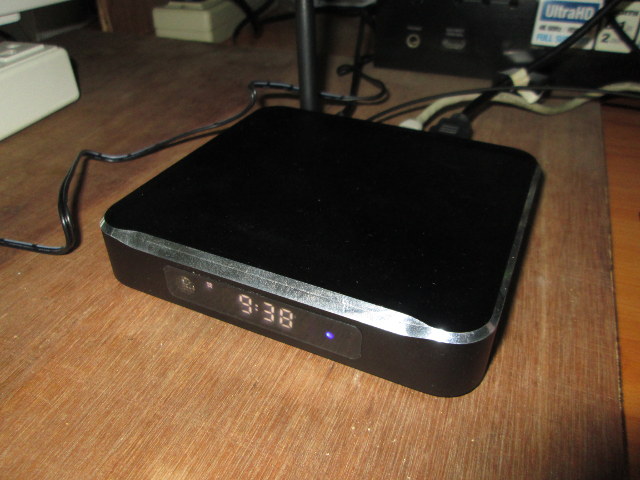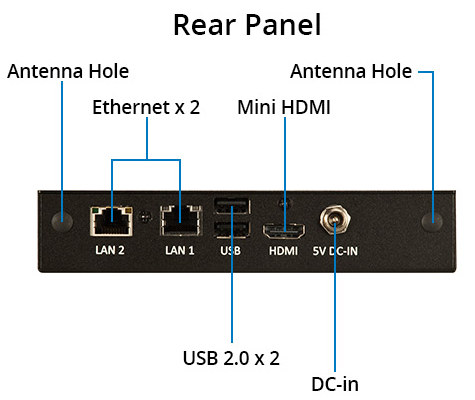Voyo V2 is another Intel Atom Z3735F mini PC pre-installed with Windows 10 Home, but it has some interesting features such as a 64GB SSD connected via a USB to SATA bridge on top of the regular 32GB eMMC, and a 5,000 mAh battery acting as a UPS. Since I have already received several of such platforms including MeLE PCG01, Wintel W8, and MeLE PCG03 and that there are usually few differences in regular benchmarks, I’ll focus on what varies between platforms: Windows activation status, storage and network performance, as well as power consumption. System Info and Windows Activation One of the shortcoming of this mini PC is that it only comes with a full sized USB port, and a micro USB port. So if you plan to use it as a PC with USB keyboard and mouse, you’ll need to use a USB hub, or at least a USB […]
Axiomtek PICO842 Fanless Bay Trail Pico-ITX Motherboard Includes a SO-DIMM Socket and SATA Ports
Axiomtek PICO842 is a fanless Pico-ITX motherboard that features Intel Celeron J1900 quad core processor or Celeron N2807 dual core processor with up to 8GB DDR3L, and aimed at IoT & medical applications, automation, and embedded systems with wide temperature range requirements. Axiomtek PICO842 specifications: SoC Intel Celeron J1900 quad core processor up to 2.42 GHz OR Intel Celeron N2807 dual core processor up to 2.16 GHz System Memory – 1x DDR3L-1066/1333 SO-DIMM up to 8GB for J1900, and 4GB for N2807 Storage – 1x SATA-300, 1x mSATA Video Output – 1x 18/24-bit single/dual channel LVDS, and 1x HDMI or 1x VGA Audio – HD Codec audio (Realtek ALC662); MIC-in/Line-out Connectivity – Gigabit Ethernet (Intel i211AT) USB – 4x USB 2.0 host port Serial – 2x COM ports supporting RS-232, RS-422, and RS-485. Expansion – mini PCI Express (shared with mSATA support) Power Supply – 12V DC power jack. Battery […]
Orange Pi PC Not Booting? You Are Not Alone…
Orange Pi PC development board launched at the end of August, and quickly went viral thanks to low $15 price tag. The company, Shenzhen Xunlong Software, is fairly small, with just over 10 employees, so when they started getting several thousands customers in a short time, they may have been overwhelmed, and this likely resulted in delays with regards to shipping, and acceptance into Orange Pi forums. Several people have now received their boards, and while many found it to work fine, I’ve been informed several people apparently got a non booting device. People on Youtube and Orange Pi Forums also complained about a booting issue until Ethernet lights up, or Ethernet not working, while other reports Linux is working, but not Android. Unless there was a bad batch during manufacturing, it’s hopefully mostly a firmware issue. The person who reports Ethernet not working, first used the images from Orange […]
ARNU Box Mach 10 Pure Linux Review
Most TV boxes on the market are running Android, but if all you’d want to do is watching online or local videos in Kodi, a Linux box may offer a more streamlined experience, and that’s exactly what ARNU Box Mach 10 Pure Linux is offering as an Amlogic S812 TV Box running Kodi 15 Linux. In my “Arnu Box Mach 10 specs, unboxing and teardown” post, we’ve already seen the box bascially uses the same PCB used in Eny M8S, but with some different memory and storage chips. But that’s the software that’s mostly interested in this box, and today, I’ll go through the first time setup and Cloudword, before testing video playback capabilities. Setting Up ARNU Box Mach 10 Pure Linux So I’ve just connected an HDMI cable, an Ethernet cable, and the power adapter to get started, and the very first time you’ll go through a detailed setup […]
VIA Artigo A820 Enterprise IoT Gateway Is Powered by Freescale i.MX 6DualLite Processor
VIa has just launched a new fanless IoT gateway targeting the enterprise market. Artigo A820 features Freescale i.MX 6DualLite Cortex A9 processor with dual Ethernet ports as well as DIO and serial ports, and optional wireless networking modules adding WiFi, 3G, and GPS connectivity. Artigo A820 specifications: SoC – Freescale i.MX 6DualLite dual core ARM Cortex-A9 @ 1.0 GHz with Vivante GC880 GPU System Memory – 1GB DDR3 SDRAM Storage – 4GB eMMC Flash + internal micro SD card Connectivity 1x Gigabit Ethernet (Micrel KSZ9031RNX with RGMII support) 1x 10/100M Ethernet (using ASIX AX88772 USB 2.0 to 10/100Mbps Fast Ethernet Controller), Optional VNT9271BU0DB IEEE 802.11 b/g/n USB Wi-Fi dongle Optional Ublox 3.75G HSPA/UMTS Mobile mini PCIe module with GPS and SIM card slot 2 Antenna holes for 3G or Wi-Fi Video Output – mini HDMI 1.4 USB – 3x USB 2.0 host ports Serial – 1x COM port for RS232/485; […]
Digilent ARTY is a $99 Xilinx Artix-7 FPGA Board with Arduino Headers
Low cost FPGA boards with Arduino headers are nothing new, as we’ve seen before with Arduissimo and Papilio DUO, but both of these boards are based on Spartan 6 FPGA, while the recent Digilent ARTY board is powered by an Artix-7 FPGA. Beside the hardware differences, Spartan 6 FPGAs only support Xilinx ISE Design Suite, while Artix-7 parts are also supported by Vivado Design Suite, which according to Xilinx has a much better workflow and user interface. Digilent ARTY specifications: FPGA – Xilinx XC7A35T-L1CSG324I with 33,280 logic cells, 1,800 Kb block RAM, 90 DSP slices, and 250 I/O pins System memory – 256 MB DDR3L SDRAM Storage – 16 MB of QSPI Flash Connectivity – 10/100M Ethernet Expansion interfaces 4 Digilent compatible Pmod interfaces enabling 32 user I/O pins: 2 Pmods routed as differential pairs, paired to fit dual-wide Pmods Arduino UNO R3 shield / chipKit interface Debugging – USB-UART Interface, […]
R8 Android 5.1 TV Box Specs, Unboxing and Teardown
There are lots of Rockchip RK3368 TV boxes on the market, and Kingnovel sent me their latest R8 TV Box for review. I’ll start by listing the specs, then take a few pictures of the device, before taking it apart to checkout the board. R8 specifications Since Kingnovel is a manufacturer – or maybe just a reseller ? -, the specifications are flexible in order to match the requirements of their clients: SoC – Rockchip RK3368 octa core Cortex A53 processor @ 1.5 GHz (1.2GHz?) with PowerVR G6110 GPU System Memory – 1 GB DDR3 (2GB optional) Storage – 8GB eMMC flash (16 or 32GB optional) + micro SD card slot or SD card slot up to 32GB Video Output – HDMI 2.0 up to 4K @ 60Hz Audio Output – HDMI, optical S/PDIF Connectivity – Ethernet, Wi-Fi 802.11 b/g/n and Bluetooth 4.0 (RTL8723 module) USB – 3x USB 2.0 […]
ARM TechCon 2015 Schedule – IoT, Servers, 64-bit ARM, Power Usage Optimization, and More
The ARM Technology Conference (ARM TechCon) will take place on November 10 – 12, 2015, in Santa Clara Convention Center, and just like every year, there will be a free exposition for companies to showcase their latest innovation and/or products, as well as a technical conference with sessions and workshops sorted into various tracks: Automotive/Embedded Vision Embedded IoT Mobile/Connectivity Networking Infrastructure/Servers Tools & Implementation Wearables/Sensors ARM Training Day Sponsored Vendor Training Special Event General Event Software Developers Workshop You can find the complete schedule on ARM TechCon website. Although I won’t attend, I’ve created my own virtual schedule with some of the sessions I found interesting. Tuesday – November 10 8:30 – 9:20 – ARM Vision for Thermal Management and Energy Aware Scheduling on Linux by Ian Rickards (ARM), Charles Garcia-Tobin (ARM), Bobby Batacharia (ARM) This talk will cover the history and where are we going, for ARM’s Power Software (IPA, […]













